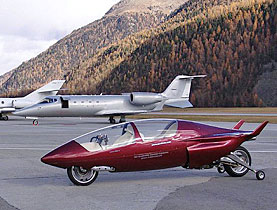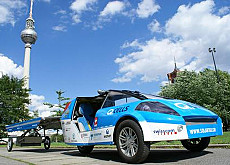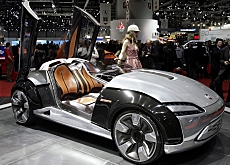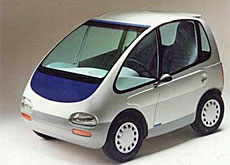Revolutionising car design

Today's cars are about as efficient as aeroplanes dragging parachutes. At least that's how innovator Peter Maskus would describe them.
The engineer spent years working for traditional car manufacturers before Germany’s strong automobile industry drove him to Lucerne, where he set up his headquarters in 2004.
“In terms of climate change, current automobile technology is a disaster,” says Maskus, who has created a futuristic vehicle that could revolutionise the way we drive.
The Acabion GTBO looks like a cross between a Formula One racecar and a fighter jet, with a top speed of 545 kilometres per hour. But the 750 horsepower machine gets up to 42 kilometres out of each litre of petrol, making it extremely fuel-efficient.
This rocket-on-wheels gets its name from nature. Acabion refers to Acadia National Park in Maine, in the United States, and the concept of bionics.
Maskus, who serves as Acabion’s chief research officer, first entertained the idea at university in 1986. The German engineer then went on to work for Porsche and Mercedes-Benz, and as a Kaizen expert for Toyota.
Bird-like
In 1995, he became a production optimisation consultant, which helped him find his true calling: innovation.
It was one thing to improve production efficiency, but what about making the product itself more efficient? This question brought Maskus back to his idea of a car with aerodynamic, bird-like features.
“There’s a direct proportion between the size at the front of a vehicle and the energy needed to make it move,” explains Maskus. “Sitting side-by-side costs us 50 per cent of our efficiency and fuel.”
This is why the Acabion seats the passenger directly behind the driver, similar to the seating arrangement of a glider plane. According to its inventor, the adoption of his technology “would give us another 50 years’ worth of petrol and more time to develop solar power”.
While the Acabion could run on petrol and use normal roads, Maskus envisages it running on solar-powered electricity along elevated tracks. Longer stretches could be tackled at high speed and on autopilot.
Underground
Closer to home, the diminutive vehicles could be driven underground in purpose-built tunnels – making residential neighbourhoods quieter, safer and greener. For families, there are also plans for four- and nine-seat vehicles based on the same technology.
“Progress isn’t a hybrid SUV. To make progress, we’ve got to think outside the box,” says Maskus, who hopes he can convince people that private mobility needs to change – and fast.
The 47-year-old drives a Toyota Corolla, but laments the 1.4 tonnes required to transport his 80 kilos. In comparison, the Acabion weighs just over 300 kilos.
It isn’t street-legal yet, but it will be. In the meantime, places including the Engadin airport near St Moritz have been used for test drives.
“We have great contacts and support here,” says Maskus. “Switzerland is a fantastic platform, and one of the best countries in the world for true and effective innovations.”
It takes about three years and SFr3 million ($2.66 million) to build an Acabion GTBO. At the moment there’s just one. But this innovator has no shortage of bright ideas.
“We cannot be stopped; we will keep on planning,” vows Maskus with a smile.
swissinfo, Susan Vogel-Misicka in Lucerne
Technical data for the Acabion GTBO
(GTBO = Grande Tourismo Bionic Optimised)
max speed: 545 kph (340 mph) at half throttle, governor limited.
0 to 480 kph (300 mph) in less than 30 seconds
160 kph (100 mph) at 1.7% throttle and 42 km per litre.
240 kph (150 mph) at 4.3% throttle and 26 km per litre.
400 kph (250 mph) at 17% throttle and 10.5 km per litre.
Bionics refers to the study of how systems occuring in nature can be applied to technology.
For example, it’s no accident that aeroplanes bear a strong resemblance to birds. (Most cars, on the other hand, look rather like tortoises.)
Kaizen is a Japanese term to describe the process of making continuous improvements. It is a concept that is especially useful for factories.

In compliance with the JTI standards
More: SWI swissinfo.ch certified by the Journalism Trust Initiative



You can find an overview of ongoing debates with our journalists here. Please join us!
If you want to start a conversation about a topic raised in this article or want to report factual errors, email us at english@swissinfo.ch.